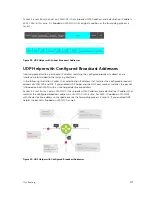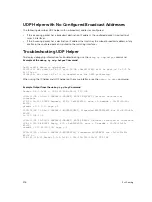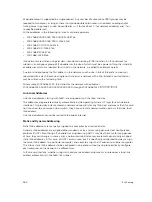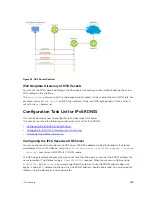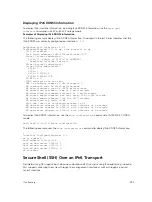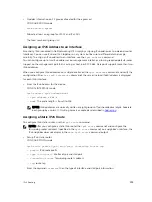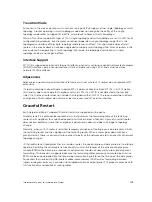
Displaying IPv6 RDNSS Information
To display IPv6 interface information, including IPv6 RDNSS information, use the
show ipv6
interface
command in EXEC or EXEC Privilege mode.
Examples of Displaying IPv6 RDNSS Information
The following example displays IPv6 RDNSS information. The output in the last 3 lines indicates that the
IPv6 RDNSS was correctly configured on interface
te 1/1
.
Dell#show ipv6 interface te 1/1
TenGigabitEthernet 1/1 is up, line protocol is up
IPV6 is enabled
Link Local address: fe80::201:e8ff:fe8b:7570
Global Unicast address(es):
1212::12, subnet is 1212::/64 (MANUAL)
Remaining lifetime: infinite
Global Anycast address(es):
Joined Group address(es):
ff02::1
ff02::2
ff02::1:ff00:12
ff02::1:ff8b:7570
ND MTU is 0
ICMP redirects are not sent
DAD is enabled, number of DAD attempts: 3
ND reachable time is 20120 milliseconds
ND base reachable time is 30000 milliseconds
ND advertised reachable time is 0 milliseconds
ND advertised retransmit interval is 0 milliseconds
ND router advertisements are sent every 198 to 600 seconds
ND router advertisements live for 1800 seconds
ND advertised hop limit is 64
IPv6 hop limit for originated packets is 64
ND dns-server address is 1000::1 with lifetime of 1 seconds
ND dns-server address is 3000::1 with lifetime of 1 seconds
ND dns-server address is 2000::1 with lifetime of 0 seconds
To display IPv6 RDNSS information, use the
show configuration
command in INTERFACE CONFIG
mode.
Dell(conf-if-te-1/1)#show configuration
The following example uses the
show configuration
command to display IPv6 RDNSS information.
!
interface TenGigabitEthernet 1/1
no ip address
ipv6 address 1212::12/64
ipv6 nd dns-server 1000::1 1
ipv6 nd dns-server 3000::1 1
ipv6 nd dns-server 2000::1 0
no shutdown
Secure Shell (SSH) Over an IPv6 Transport
Dell Networking OS supports both inbound and outbound SSH sessions using IPv6 addressing. Inbound
SSH supports accessing the system through the management interface as well as through a physical
Layer 3 interface.
IPv6 Routing
391
Summary of Contents for Z9000
Page 1: ...Dell Configuration Guide for the Z9000 System 9 7 0 0 ...
Page 80: ...grub reboot 80 Management ...
Page 128: ... 0 Te 1 1 Te 1 2 rx Flow N A N A 128 Access Control Lists ACLs ...
Page 491: ...Figure 70 Configuring OSPF and BGP for MSDP Multicast Source Discovery Protocol MSDP 491 ...
Page 496: ...Figure 73 MSDP Default Peer Scenario 1 496 Multicast Source Discovery Protocol MSDP ...
Page 497: ...Figure 74 MSDP Default Peer Scenario 2 Multicast Source Discovery Protocol MSDP 497 ...
Page 498: ...Figure 75 MSDP Default Peer Scenario 3 498 Multicast Source Discovery Protocol MSDP ...
Page 760: ...Figure 100 Single and Double Tag TPID Match 760 Service Provider Bridging ...
Page 761: ...Figure 101 Single and Double Tag First byte TPID Match Service Provider Bridging 761 ...

